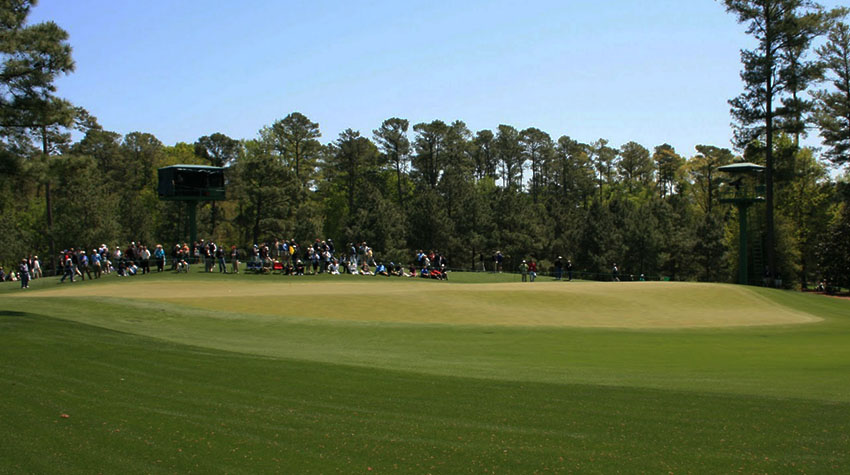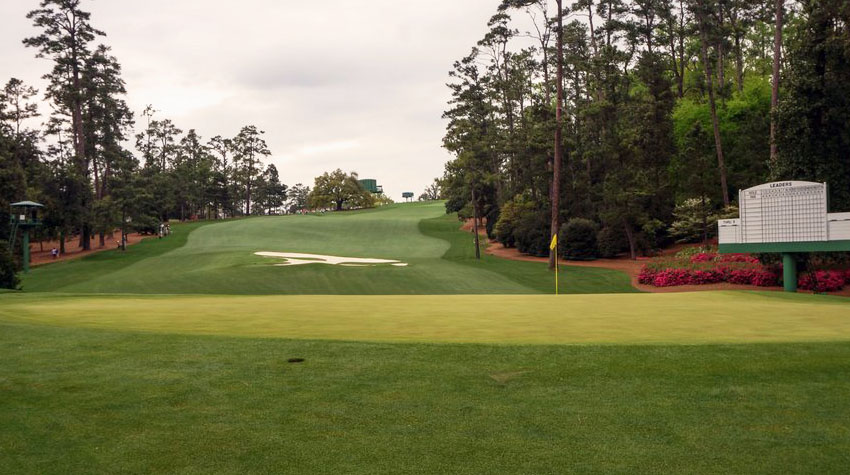
The 12th will present its usual daunting challenge at the Augusta National Women's Amateur (Pinterest photo)
If you want to see the true genius of Augusta National, tune into the Augusta National Women’s Amateur, played the week before the Masters.
With all the hype surrounding the new event, it is easy to forget that only one of the three rounds will be played at
Augusta National Golf Club. The first two rounds will be held at nearby Champions Retreat Golf Club, with the low 30 scorers advancing to the hallowed grounds for the final round. The atmosphere at Champions Retreat will likely resemble that of a Tour qualifying school, with just as much attention around the cut line as there will be around the leaders.
Once the cut is made, there will be another rarity – a practice round in between official tournament rounds. The entire field will play a practice round at Augusta National on the tournament’s off day, with the final round played a day later.
Related: Full field: Augusta National Women's Amateur confirmed entries
Once the world’s top women’s amateur golfers set foot on the property, patrons and television viewers will see a side of Augusta National they have never seen before. And for purists it may just be better than what they see the following week when the professional men return for the Masters.
For years, the original Alister Mackenzie and Bobby Jones layout stood the test of time as the ultimate in strategic design. It wasn’t enough to be in the fairway – the player had to come in from the correct side to gain an advantage, and had to choose the optimal trajectory on the approach to negotiate the contours and elevation changes and get the ball close to the hole.
As equipment improved and players became more athletic, the power game began to overwhelm Augusta National, and the course was transformed in response. Holes were lengthened. Trees were planted. Fairways were narrowed. Rough was introduced. Green speeds were increased. Now, the formula for success is long driving, high spinning approach shots, and short game wizardry.
As the course has evolved to retain its challenge to the world’s best players, some of its most unique design features have faded in relevance. But with the top women’s amateurs soon to arrive, these features are lying in wait, poised to return to prominence and to give viewers a peek at how the course once played, and just maybe how it was meant to play all along. Here are a few examples.
The 5th and 14th greens
These greens have to be seen to be believed, and were designed by Mackenzie to encourage and challenge a running approach. The 5th green has a six-foot tall false front, with falloffs on either side, and runs away from the player. In Mackenzie’s day the player had to figure out where to land the ball and what trajectory would allow it to bound up over the false front but not run over the green. Today’s player just hits it high to carry the false front with as much spin as possible.

From short-left of the 14th green, the false front can be measured by the height of the flagstick and the spectators (Ian Andrew took this photo and has an excellent detailed description of this green)
The false front at the 14th is even more severe – so much so that any ball coming up short brings 6 into play. Beyond the false front is a three-level green cascading from top left to bottom right, and here again today’s professionals go for the high trajectory, high spin approach to take the contours out of play as much as possible.
The women amateur field at the Augusta National Women’s Amateur will not have that luxury – they will have to take on the contours and control their trajectories to get the ball anywhere near the hole, or even to stay on the putting surface.
There is a theory espoused by some purists that says the longer the ball is in motion after it lands, the more interesting golf is to watch. We will see plenty of balls running, bounding, and trickling all around the greens as the women reintroduce the ground game to Augusta National.
The 3rd, 12th and 15th greens
No one knows where the pins will be set for the final round of the Augusta National Women’s Amateur, but the possibility exists for some truly terrifying approach shots should the Committee decide to utilize some of the shallower portions of these three greens.
The 3rd green tilts from right to left, with the left portion of the green only 11 yards deep, with drop-offs in front and behind. At the Masters, the play is to drive the ball just in front of the green, or lay back and hit a high-spinning wedge. For the women, any pin on the left side of the 3rd green will require a near-perfect approach, or a bail out to the high side of the green which will leave one of the fastest putts on the course.
No matter where the pin is on the famed 12th and the 15th, the approach shots will have to be struck perfectly to hold the shallow greens. The swirling winds at the 12th will only be slightly less perplexing for a lower-flying shot, and the shot into the 15th will likely become the single most challenging approach on the entire course.

From a tight downhill lie, the shot to the 15th is scary (Carl Murphy photo)
In fact no hole will play more differently for the women than the 15th. For the professional men, the 15th at Augusta is all about the second shot. After a big drive to the top of the hill, it is anywhere from a mid-iron to a fairway wood into the green, with the ball hanging in the air seemingly forever before hopefully clearing the water and finding the shallow tabletop green in two for an eagle putt.
For the women, the 15th will be a three-shot hole, and angles will be all-important. The approach will be truly scary – from a downslope over the water to a green that is only 15 yards deep on the left and 25 deep on the right, with a tightly-mown drop off beyond. If the pin in on the left, and approach will have to come from the extreme right side of the fairway, with the reverse being true if the pin is on the right.
Fairway slopes at the 10th, 13th and 14th
The lower the drive, the more it runs, which for the women will make some of Augusta National’s fairway contours more impactful on some key tee shots.
In the past, players would have to hit a slinging hook to take advantage of the downslope on the left side of the 10th fairway. A right-to-left shot is still the preferred play for the pros, but the higher-trajectory tee shots often fly to the bottom with only minimal roll, and the threat for not turning it over isn’t as dire as it used to be. For the women, the reward for the aggressive line and proper trajectory will be restored.

From behind the 10th, the "speed slot" can be seen on the inside of the dogleg (Andy Johnson/Fried Egg photo)
Before the club purchased land from nearby Augusta Country Club to build a new 13th tee, Bubba Watson famously carried the trees on the left for a sand wedge approach shot and an easy birdie en route to his second Masters title. The women will play an entirely different hole, and though it remains to be seen if it will be set up to allow them to reach the green in two shots, any chance they have will rely on utilizing the right-to-left bank of the fairway to get as much roll as possible.
While using the contours of the 10th and 13th are to the player’s advantage, the opposite is true at the 14th. There the fairway doglegs right to left while the slope runs to the outside of the dogleg toward the rough and trees. Only a well-struck tee shot turned into the slope will be able to stay in the fairway and provide a clear approach to the spectacularly contoured green.
A test for all time
Angles, trajectories, the ground game – just as Mackenzie and Jones intended. Expect all to make a comeback when the women tee it up for the first time at Augusta National. Get ready to see a side of Augusta you have never seen before.
The final round of the
Augusta National Women’s Amateur will be Saturday, April 6 and will be televised on NBC. AmateurGolf.com will be on the grounds at Champions Retreat and Augusta National for in-depth coverage.